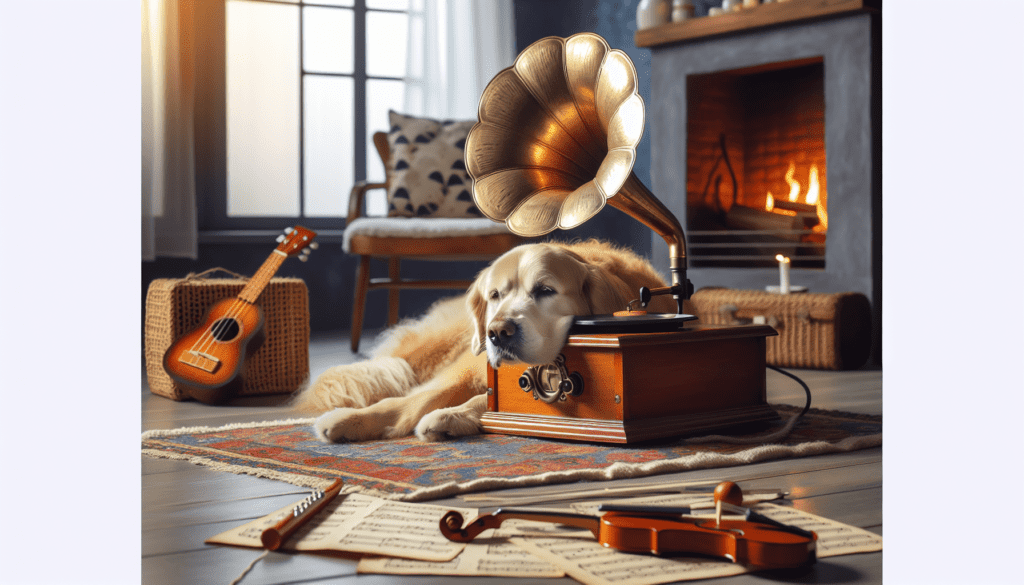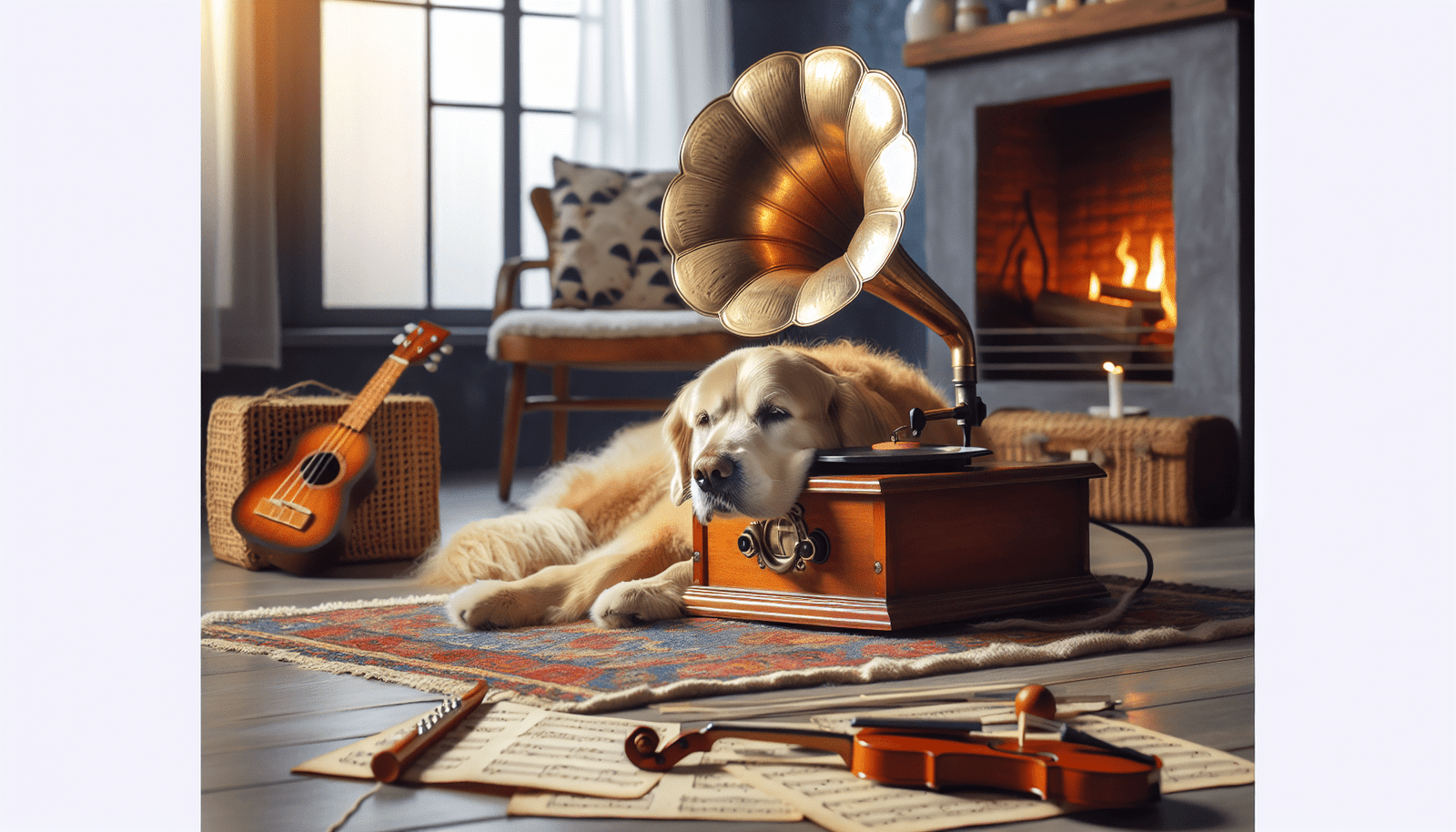If your furry friend tends to get anxious or stressed, you may find yourself constantly searching for ways to help them relax. One option to consider is music or sound therapy. But can these soothing sounds really make a difference for your anxious dog? In this article, we will explore whether music or sound therapy can be effective in calming an anxious dog, giving you the insights you need to create a peaceful and stress-free environment for your beloved pet.
Introduction
If you have an anxious dog, you know how distressing it can be to see them overwhelmed and uneasy. Fortunately, music or sound therapy can be a powerful tool in helping to calm and soothe your furry friend. By understanding anxiety in dogs and the benefits of music therapy, you can effectively implement this technique to create a more peaceful environment for your canine companion.
Understanding anxiety in dogs
Anxiety in dogs can be caused by a variety of factors, including separation, loud noises, past traumas, or changes in their environment. It is important to recognize the signs of anxiety so that you can provide the necessary support and care for your furry friend.
Causes of anxiety in dogs
Anxiety in dogs can stem from various causes, such as separation anxiety when left alone, noise phobias triggered by thunderstorms or fireworks, or fear and anxiety related to traumatic experiences. Identifying the root cause of your dog’s anxiety is crucial in addressing it effectively.
Common signs of anxiety in dogs
Dogs express anxiety through behavioral and physiological symptoms. Common signs include excessive barking or whining, trembling, pacing, aggression, destructive behavior, loss of appetite, and excessive panting. Recognizing these signs is essential in identifying when your dog might benefit from music or sound therapy.

Benefits of music or sound therapy for dogs
Using music or sound therapy can provide numerous benefits for anxious dogs. By incorporating calming tunes or sounds into their environment, you can help reduce their stress and anxiety levels, promote relaxation, improve sleep patterns, and provide a healthy distraction.
Reduces stress and anxiety
Music or sound therapy has been shown to have a calming effect on dogs. Certain types of music or sounds can help reduce the levels of stress hormones, such as cortisol, in your dog’s body, allowing them to relax and feel more at ease.
Enhances relaxation
The soothing melodies and gentle rhythms of music or sounds have a tranquilizing effect on dogs. It can help lower their heart rate and blood pressure, inducing a state of relaxation that allows them to unwind from their anxious thoughts and emotions.
Promotes better sleep
Anxious dogs often struggle with sleep disturbances, leading to exhaustion and further exacerbating their anxiety. Music or sound therapy can help create a soothing ambiance that promotes a peaceful sleep environment, allowing your dog to get the rest they need.
Serves as a distraction
Music or sound therapy can act as a positive distraction for anxious dogs. By playing calming tunes or sounds, you can redirect their focus away from the source of their anxiety, providing relief and helping them to feel more at ease.
Types of music or sounds used in therapy
When it comes to music or sound therapy for dogs, different genres and sounds can have varying effects on their emotions and behavior. Here are some common types of music and sounds used to calm anxious dogs:
Classical music
Classical compositions have been found to have a soothing effect on dogs. The gentle melodies and harmonies can help calm their nerves and create a peaceful atmosphere.
Reggae music
Reggae music with its rhythmic beats and chilled vibes can also have a calming effect on dogs. The slow tempo and laid-back nature of reggae can help reduce stress and anxiety in your four-legged friend.
Soft rock music
Soft rock music is another genre that can be beneficial for anxious dogs. Its melodic tunes and mellow sounds can create a comforting environment, helping to alleviate their anxiety.
Nature sounds
The sounds of nature, such as birds chirping, gentle waves, or rustling leaves, can have a tranquilizing effect on dogs. Playing recordings of these soothing natural sounds can help create a sense of serenity for your furry friend.
White noise
White noise, such as the sound of a fan or a low static-like noise, can also be used in music or sound therapy. White noise has a masking effect, helping to drown out loud or sudden noises that may trigger anxiety in dogs.
How music or sound therapy works for dogs
The effectiveness of music or sound therapy lies in its ability to influence dogs’ brainwaves, elicit a physiological response, and create positive associations.
Affects the dog’s brainwaves
Research has shown that certain types of music can synchronize with a dog’s brainwaves, helping to induce a state of relaxation. The rhythmic patterns and frequencies of the music can influence the dog’s brain activity and promote a sense of calm.
Elicits a physiological response
Music or sound therapy can also elicit a physiological response in dogs. The calming melodies and sounds can slow their heart rate, lower blood pressure, and reduce muscle tension, leading to a more relaxed state.
Creates a positive association
By consistently incorporating music or sound therapy during times of anxiety or stress, dogs can develop a positive association with the calming tunes or sounds. This association can help them feel comforted and secure, contributing to their overall well-being.
Choosing the right music or sounds for your dog
When choosing music or sounds for your dog, it is essential to consider their preferences and sensitivities. Here are some tips to help you select the right tunes or sounds for your furry friend:
Consider your dog’s preferences
Observe how your dog responds to different genres or sounds. Some dogs may prefer classical music, while others may find nature sounds more soothing. Pay attention to their reactions and choose music or sounds that they find calming.
Experiment with different genres and sounds
Every dog is unique, so it may take some trial and error to find the perfect music or sounds for your furry friend. Experiment with different genres and sounds to see which ones have the most positive impact on your dog’s anxiety levels.
Seek professional advice if necessary
If you are unsure which music or sounds to choose, consider consulting a professional animal behaviorist or veterinarian. They can provide personalized recommendations based on your dog’s specific needs and preferences.
Implementing music or sound therapy
To effectively implement music or sound therapy for your anxious dog, it is important to create a calming environment, use appropriate speakers or headphones, and consider the timing and duration of therapy sessions.
Create a calming environment
Choose a quiet and comfortable space where your dog can relax and listen to the music or sounds undisturbed. Remove any potential stressors from the environment and create a soothing ambiance with dim lighting and comfortable bedding.
Use appropriate speakers or headphones
Invest in high-quality speakers or headphones to ensure that the music or sounds are played at the right volume and clarity. Avoid using earbuds or headphones directly on your dog, as this may cause discomfort or anxiety.
Timing and duration of therapy sessions
Introduce music or sound therapy during times when your dog is most likely to experience anxiety, such as during a thunderstorm or when left alone. Gradually increase the duration of therapy sessions, starting with shorter periods and gradually extending them as your dog becomes more accustomed to the calming effects.
Additional calming techniques for anxious dogs
While music or sound therapy can be incredibly beneficial, it is important to incorporate other calming techniques to further support your anxious dog’s well-being.
Bonding and positive reinforcement
Building a strong bond with your dog and reinforcing positive behaviors can help alleviate anxiety. Spend quality time together, engage in training exercises using positive reinforcement, and provide plenty of praise and affection.
Exercise and mental stimulation
Regular exercise and mental stimulation are essential for reducing anxiety in dogs. Engage in daily walks, play interactive games, and provide puzzle toys or enrichment activities to keep your dog’s mind and body active.
Aromatherapy and essential oils
Certain scents, such as lavender or chamomile, have calming properties that can help relax anxious dogs. Consider using diffusers or sprays with pet-friendly essential oils to create a soothing aroma in your dog’s environment.
Risks and limitations of music or sound therapy for dogs
While music or sound therapy can be highly effective, it is important to be aware of its limitations and seek professional support when necessary.
Not a substitute for professional treatment
Music or sound therapy should not be used as a substitute for professional treatment. If your dog’s anxiety is severe or persistent, consult with a veterinarian or animal behaviorist for a thorough evaluation and appropriate treatment plan.
May not work for all dogs
Not all dogs will respond the same way to music or sound therapy. Each dog has individual preferences and sensitivities, so it is possible that certain types of music or sounds may not have the desired calming effect. Be patient and open to trying different approaches.
Volume and intensity considerations
It is important to consider the volume and intensity of the music or sounds used in therapy. Excessive volume can potentially increase anxiety levels in dogs or cause discomfort. Always play the music or sounds at a moderate volume, ensuring that it does not overwhelm or disturb your furry friend.
Conclusion
Music or sound therapy can be a valuable tool in helping to calm and soothe anxious dogs. By understanding the benefits, types of music or sounds, and how this therapy works, you can effectively implement it in your dog’s routine. Remember to consider your dog’s preferences, create a calming environment, and incorporate other calming techniques to provide holistic support for your furry friend’s well-being. With patience and consistency, you can help your anxious dog find peace and tranquility through the power of music or sound therapy.

